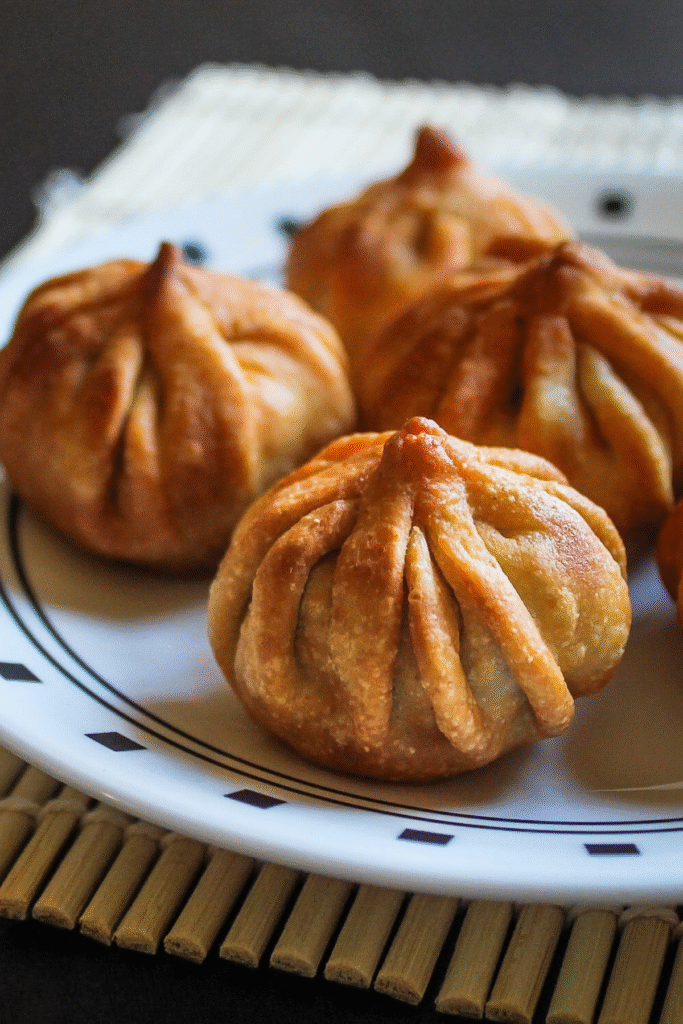Celebrate Ganesh Chaturthi with these golden, crispy Fried Modak, a divine treat that’s both festive and flavorful. These delightful sweet dumplings are made with a flaky outer crust and filled with a fragrant mixture of coconut and jaggery, infused with hints of cardamom. Deep-fried to perfection, they offer a delicious crunch with every bite, revealing a rich, gooey center that melts in your mouth.
Traditionally offered as bhog to Lord Ganesha, these modaks are not just a prasad but a symbol of devotion and joy. Easy to prepare and irresistibly delicious, they’re sure to be the highlight of your festive platter and win Bappa’s blessings!
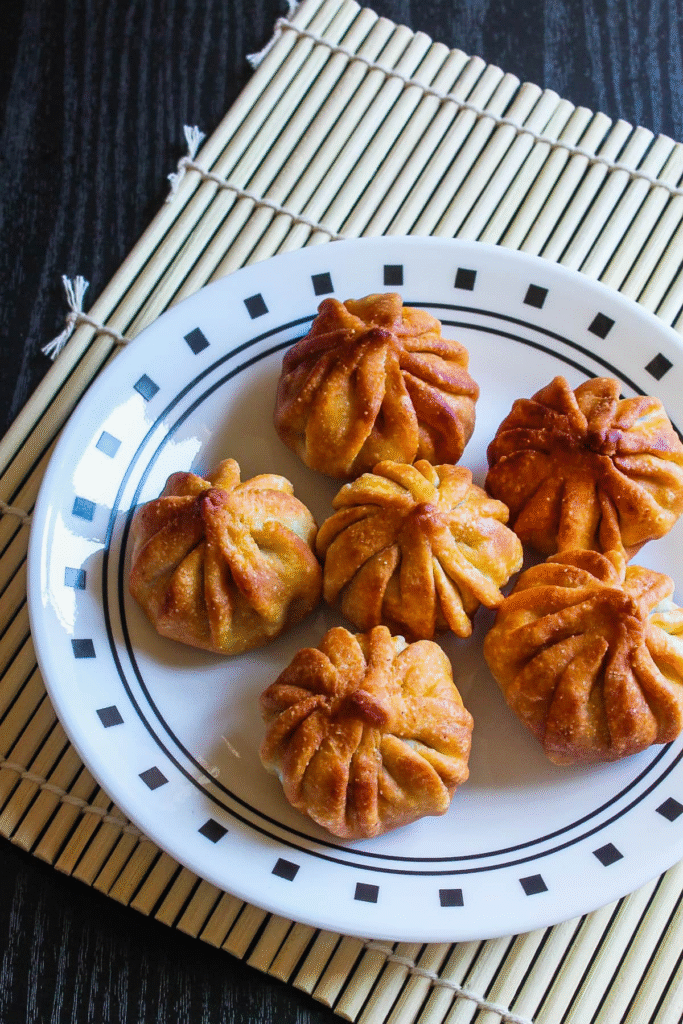
❤️ You’ll Love This Fried Modak Recipe
- This fried modak recipe is a reliable and beginner-friendly option that turns out perfect every time.
- I’ve always admired the elegant pleats of traditional ukadiche modak, but shaping them by hand has never been my strong suit. That’s why I love this fried version—it’s so much easier to shape, especially with the help of moulds. You’ll see in the step-by-step photos below just how simple it is to achieve a beautifully finished modak.
- Though the process takes a bit of time (just under an hour), preparing this sweet offering with love and sincerity makes it all worthwhile. After all, when made with true devotion, I believe Bappa will accept it with a smile.
🧾 Ingredient Notes
Here’s a quick glimpse at all the ingredients required for making fried modak — only 8 in total! You’ll need 3 basic ingredients to whip up the sweet coconut-jaggery stuffing and 5 pantry-friendly items to prepare the crunchy, golden outer shell. Simple ingredients, divine results!
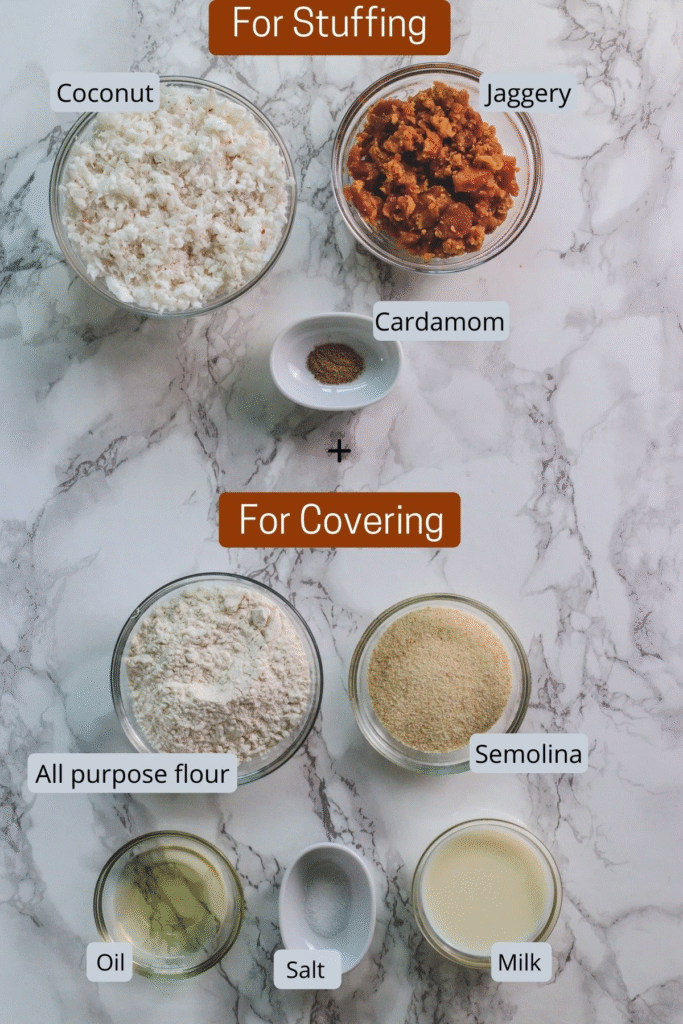
- Coconut: Freshly grated coconut gives the best flavor and texture, but it’s not easy to find where I live in the USA. So, I rely on frozen grated coconut, which is conveniently available at most Indian grocery stores and works just as well.
- Jaggery: I prefer using soft desi gur for its rich taste and easy melting. However, you can opt for any variety you have on hand—whether it’s powdered jaggery or grated chunks from a solid block.
- Semolina: Adding a bit of semolina to the dough helps create an outer shell that turns beautifully crisp and golden when fried.
👩🍳 How To Make Fried Modak? (Pics)
Making Stuffing:
1) In a pan set over medium heat, combine jaggery, thawed grated coconut, and a pinch of cardamom powder.
2) Keep stirring the mixture steadily as it starts to heat, ensuring everything cooks evenly without sticking or burning. Let it simmer until it thickens and the excess moisture starts to evaporate. This usually takes around 4 to 5 minutes, but the time may vary depending on how much mixture you’re preparing and the moisture content of your coconut. Once the mixture reaches a sticky, thick consistency, transfer it to a plate and allow it to cool completely before using.

Making Dough:
3) In a large mixing bowl, add all-purpose flour, semolina, and a dash of salt. Give it a quick stir to evenly distribute the ingredients before moving on to the next step. Drizzle in the oil and mix it in by rubbing the mixture between your fingertips and thumbs until it resembles a crumbly, breadcrumb-like texture.
4) Gradually pour in milk, a little at a time, and begin kneading the mixture into a dough in Fried Modak.
5) Knead until the dough becomes smooth and slightly firm—not overly soft or sticky. Once done, cover the dough with a cloth or lid and let it rest for about 10 minutes to allow the gluten to relax.
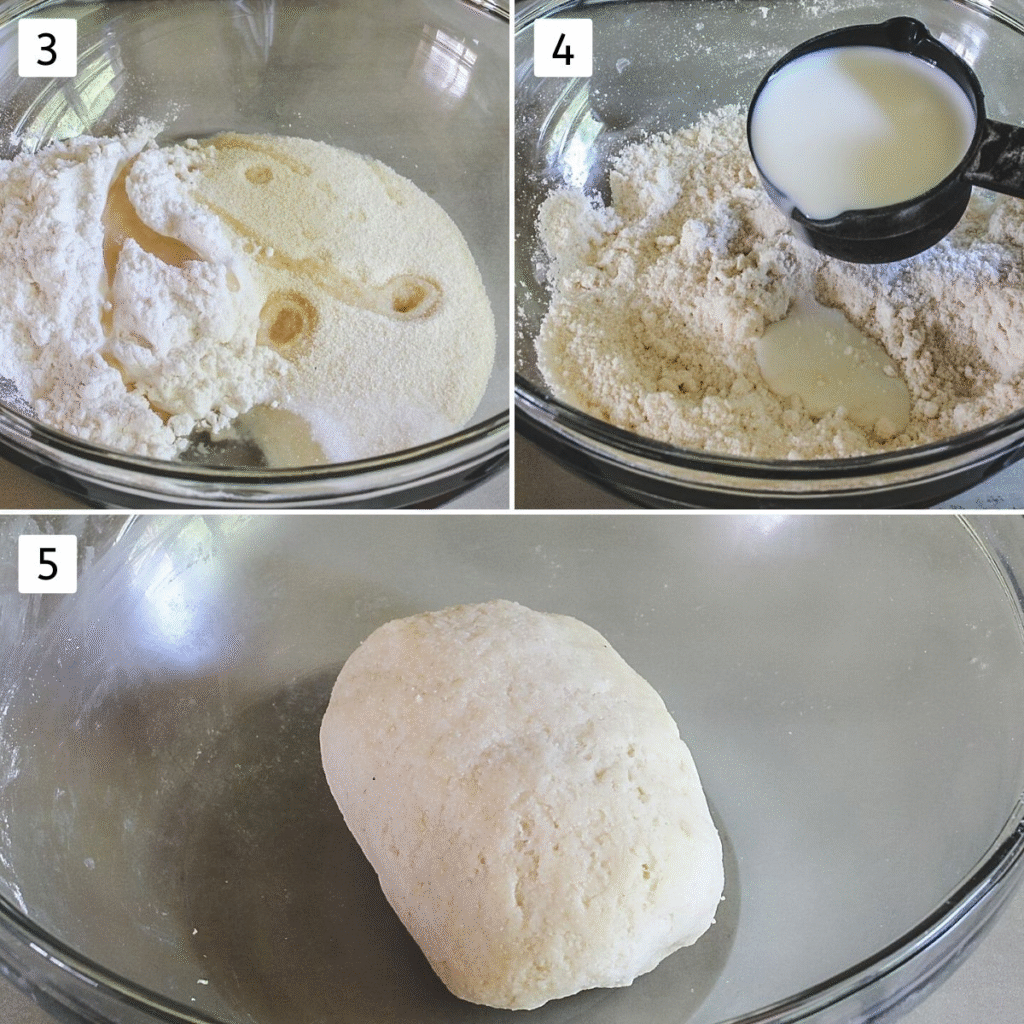
Shaping Modaks:
6) After allowing the dough to rest for 10 minutes, knead it briefly once more to smooth it out. Then, divide the dough into 10 equal-sized portions. Shape each dough portion into a smooth, crack-free ball, then softly press it between your palms to form a flat disc. Place one disc on the rolling board, and keep the rest covered with a damp kitchen towel to prevent them from drying out.
7) Using a rolling pin, roll the flattened disc into a small circle roughly 4 inches in diameter. Make sure to roll the edges slightly thinner than the center—this helps with easy pleating and prevents tearing when sealing.
8) Spoon a portion of the cooled coconut-jaggery filling into the center of the rolled disc. Lightly moisten the outer edge with water or milk using your fingertips or a pastry brush to help seal the modak properly.
9) Begin forming pleats around the edge by gently pinching with your thumb and forefinger, working your way around the circle. Getting perfectly even pleats may take some practice—placing them close together gives the modak a graceful, traditional look that elevates its presentation.
10) Once you’ve shaped all the pleats, gently bring them together at the top and press firmly to seal the modak. Make sure the seal is secure and tight to prevent any of the sweet filling from leaking out during frying
11) Continue the same process with the rest of the dough balls. As you begin shaping the final batch of modaks, place a deep pan on the stove and start heating oil over medium flame. This way, the oil will be ready for deep or shallow frying by the time your modaks are shaped.
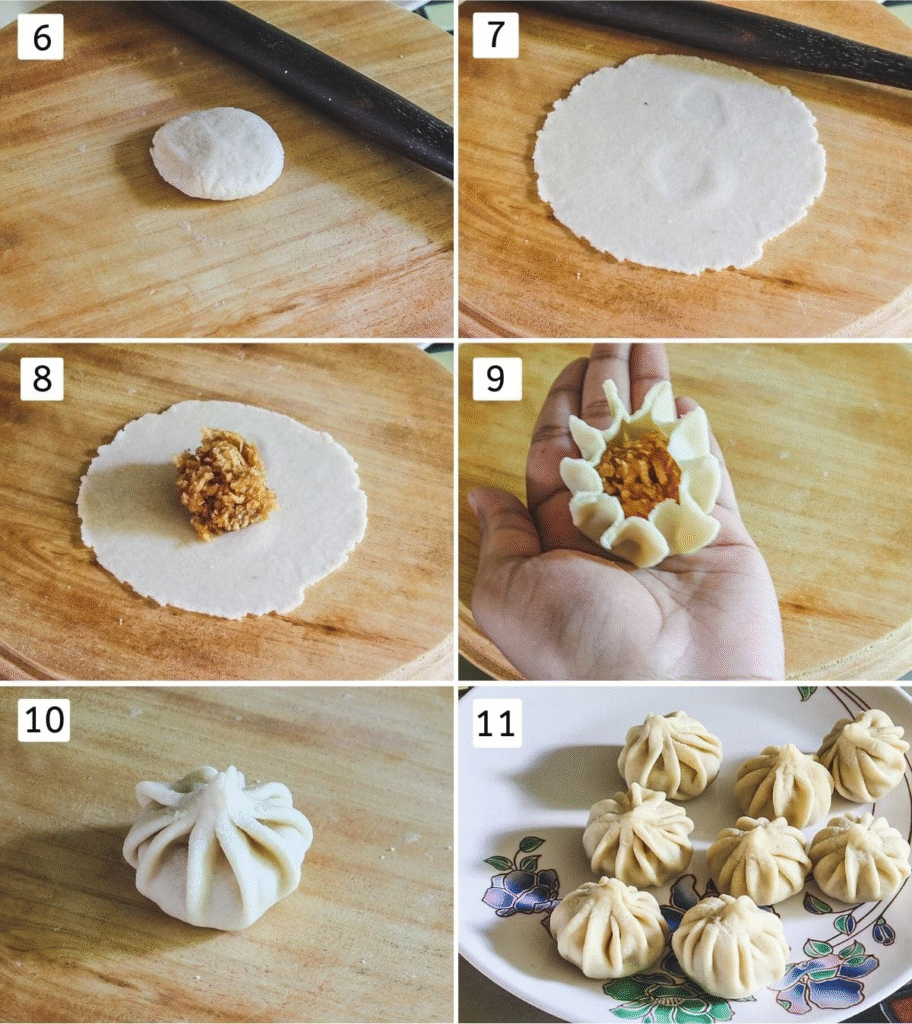
Frying Modak:
12) Gently slide the shaped modaks into the hot oil, ensuring the temperature is medium to medium-high. Fry them gently until they achieve a deep golden hue and a satisfying crunch on every side, ensuring even crispness throughout.
13) Keep turning the modaks regularly to ensure uniform color and crispiness. Since I opted for shallow frying, I had to rotate them often to get even browning. If you’re deep frying, less movement is needed as they get surrounded by oil.
14) When they’re evenly golden and irresistibly crisp, lift them out with a slotted spoon and transfer them onto a paper towel-lined plate to soak up the extra oil. Allow the modaks to cool completely before presenting them as prasad to Lord Ganesha.
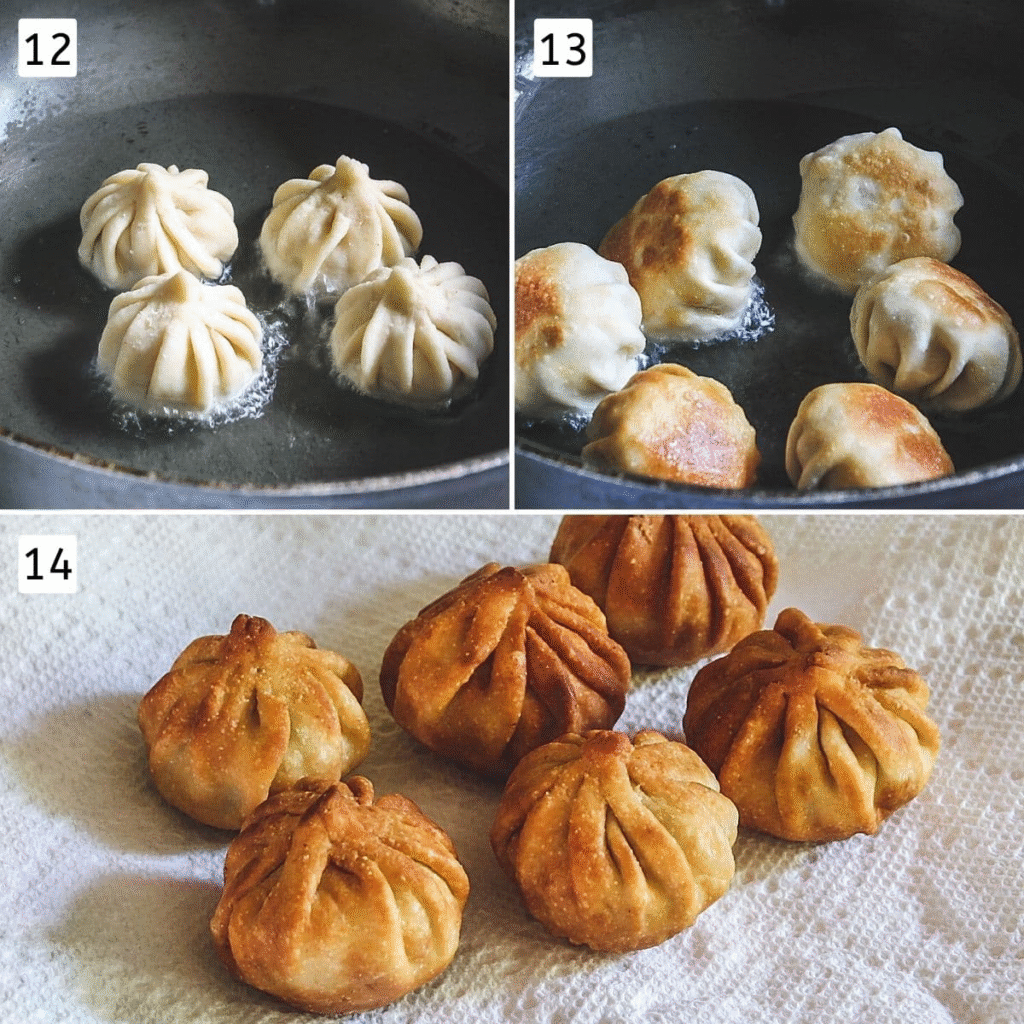
💭 Expert Tips For Fried Modak Recipe
- Ensure the edges are sealed tightly; if not sealed properly, the filling may leak during frying and stick to the surface of the modak, making them look untidy and potentially spoiling the oil.
- You can opt for whole wheat flour instead of all-purpose flour to make a more wholesome and nutritious version. Just keep in mind that the outer layer will turn out a bit denser due to the nature of wheat flour.
- oil: Drop a small pinch of the dough into the heated oil and observe how it behaves:
- If the dough rises to the surface almost instantly and starts sizzling vigorously, the oil is overheated. Frying at this temperature will brown the outer shell too quickly while leaving the inside undercooked. Reduce the heat slightly and wait for it to cool down a bit before continuing.
- If the dough drops to the bottom and lingers there without rising quickly, it’s a clear sign that the oil hasn’t reached the right frying temperature. This means the oil is still too cool, which can result in greasy, undercooked modaks. This will result in soggy, oil-soaked modaks with an uneven texture. Increase the heat slightly and give it another minute or two to heat up.
- If the dough bit first sinks and then rises slowly to the surface within a couple of seconds, it means the oil has reached the perfect frying temperature. This medium heat ensures that the modaks will cook evenly, turning golden brown and crisp on the outside while allowing the filling to heat through properly.
Instructions
Preparing the Stuffing:
- In a non-stick pan over medium heat, combine jaggery, thawed coconut, and a pinch of cardamom powder.
- Stir continuously, allowing the jaggery to melt and blend with the coconut.
- Cook until the mixture thickens and most of the moisture evaporates—this usually takes about 4–5 minutes.
- Once the filling reaches a sticky and semi-dry consistency, transfer it to a plate and let it cool down completely.
Making the Dough:
- In a mixing bowl, add all-purpose flour, semolina (rava), and a pinch of salt.
- Drizzle in some oil and mix using your fingertips, rubbing the flour mixture between your thumb and fingers until it resembles coarse crumbs.
- Gradually pour in milk, a little at a time, and knead into a smooth yet slightly firm dough—not too soft or sticky.
- Cover the dough with a damp cloth and set it aside to rest for 10 minutes.
Frying the Modaks:
- As you begin shaping the final few modaks, place a deep frying pan on the stove and start heating oil over a medium flame. This ensures the oil reaches the right temperature by the time you’re ready to fry Modak.
- Once the oil is moderately hot, gently slide the modaks into the oil one by one.
- Fry them until they turn golden brown and crisp on all sides, rotating occasionally for even cooking. Fried Modak.
- Remove the fried modaks using a slotted spoon and place them on a plate lined with paper towels to absorb excess oil.
- Let them cool completely before serving or offering.
